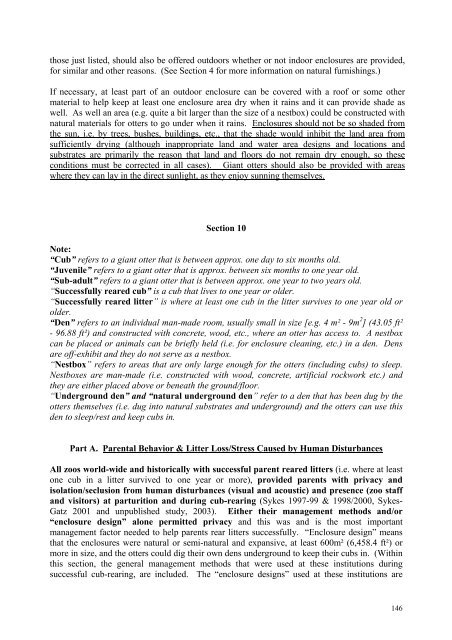International Giant Otter Studbook Husbandry and Management
International Giant Otter Studbook Husbandry and Management
International Giant Otter Studbook Husbandry and Management
You also want an ePaper? Increase the reach of your titles
YUMPU automatically turns print PDFs into web optimized ePapers that Google loves.
those just listed, should also be offered outdoors whether or not indoor enclosures are provided,<br />
for similar <strong>and</strong> other reasons. (See Section 4 for more information on natural furnishings.)<br />
If necessary, at least part of an outdoor enclosure can be covered with a roof or some other<br />
material to help keep at least one enclosure area dry when it rains <strong>and</strong> it can provide shade as<br />
well. As well an area (e.g. quite a bit larger than the size of a nestbox) could be constructed with<br />
natural materials for otters to go under when it rains. Enclosures should not be so shaded from<br />
the sun, i.e. by trees, bushes, buildings, etc., that the shade would inhibit the l<strong>and</strong> area from<br />
sufficiently drying (although inappropriate l<strong>and</strong> <strong>and</strong> water area designs <strong>and</strong> locations <strong>and</strong><br />
substrates are primarily the reason that l<strong>and</strong> <strong>and</strong> floors do not remain dry enough, so these<br />
conditions must be corrected in all cases). <strong>Giant</strong> otters should also be provided with areas<br />
where they can lay in the direct sunlight, as they enjoy sunning themselves.<br />
Section 10<br />
Note:<br />
“Cub” refers to a giant otter that is between approx. one day to six months old.<br />
“Juvenile” refers to a giant otter that is approx. between six months to one year old.<br />
“Sub-adult” refers to a giant otter that is between approx. one year to two years old.<br />
“Successfully reared cub” is a cub that lives to one year or older.<br />
“Successfully reared litter” is where at least one cub in the litter survives to one year old or<br />
older.<br />
“Den” refers to an individual man-made room, usually small in size [e.g. 4 m² - 9m 2 ] (43.05 ft²<br />
- 96.88 ft²) <strong>and</strong> constructed with concrete, wood, etc., where an otter has access to. A nestbox<br />
can be placed or animals can be briefly held (i.e. for enclosure cleaning, etc.) in a den. Dens<br />
are off-exhibit <strong>and</strong> they do not serve as a nestbox.<br />
“Nestbox” refers to areas that are only large enough for the otters (including cubs) to sleep.<br />
Nestboxes are man-made (i.e. constructed with wood, concrete, artificial rockwork etc.) <strong>and</strong><br />
they are either placed above or beneath the ground/floor.<br />
“Underground den” <strong>and</strong> “natural underground den” refer to a den that has been dug by the<br />
otters themselves (i.e. dug into natural substrates <strong>and</strong> underground) <strong>and</strong> the otters can use this<br />
den to sleep/rest <strong>and</strong> keep cubs in.<br />
Part A. Parental Behavior & Litter Loss/Stress Caused by Human Disturbances<br />
All zoos world-wide <strong>and</strong> historically with successful parent reared litters (i.e. where at least<br />
one cub in a litter survived to one year or more), provided parents with privacy <strong>and</strong><br />
isolation/seclusion from human disturbances (visual <strong>and</strong> acoustic) <strong>and</strong> presence (zoo staff<br />
<strong>and</strong> visitors) at parturition <strong>and</strong> during cub-rearing (Sykes 1997-99 & 1998/2000, Sykes-<br />
Gatz 2001 <strong>and</strong> unpublished study, 2003). Either their management methods <strong>and</strong>/or<br />
“enclosure design” alone permitted privacy <strong>and</strong> this was <strong>and</strong> is the most important<br />
management factor needed to help parents rear litters successfully. “Enclosure design” means<br />
that the enclosures were natural or semi-natural <strong>and</strong> expansive, at least 600m² (6,458.4 ft²) or<br />
more in size, <strong>and</strong> the otters could dig their own dens underground to keep their cubs in. (Within<br />
this section, the general management methods that were used at these institutions during<br />
successful cub-rearing, are included. The “enclosure designs” used at these institutions are<br />
146

















